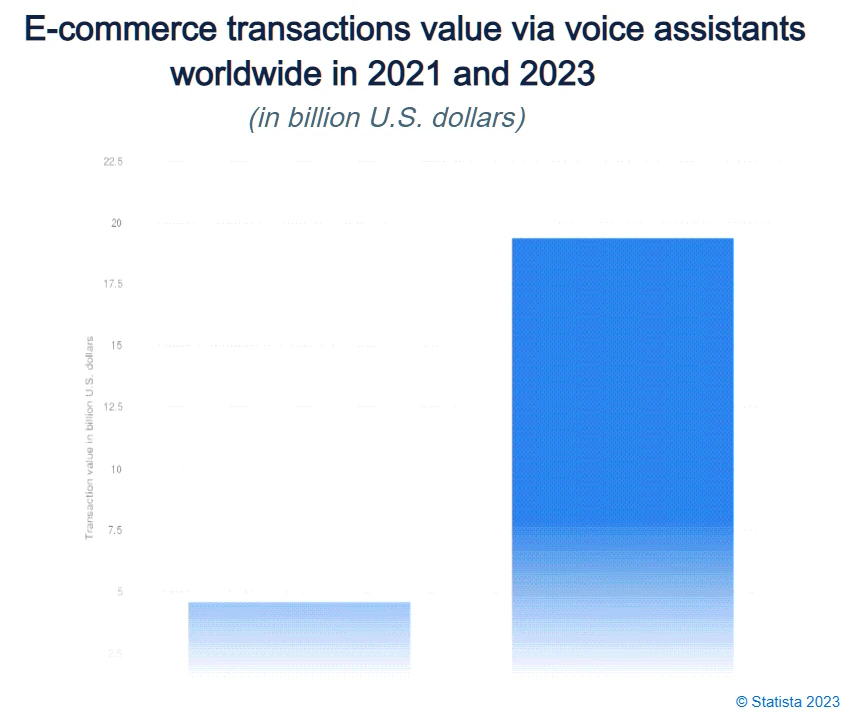Voice Search Ecommerce: A Complete Guide
-
 Eugen Barilyuk
Eugen Barilyuk
- e-Commerce Tips
- 7 min read
E-commerce is built on several cornerstone technological advancements, with immediate search functionality being one of them. It may be that these capabilities shape how an ordinary person interacts with digital platforms. A large portion of the population primarily resorts to text-based search as their go-to method however, a new stack of technologies has emerged with a transformative pledge. The advancements is the sectors of AI and computing power have transformed a voice-based search into widely available that now alters the dynamics of e-commerce in profound ways.
Types of search
Just imagine an online store as a physical retail store with aisles filled with goods. The journey through its vast product catalog to the desired item can take quite some time. Luckily, in the online world, it is possible to teleport directly to the product a shopper requires. This teleport is known as a search function. Instead of a shopper trying to find where a product is located, the store searches it for him.
Text search
Text-based search has been the cornerstone of online commerce since the inception of online commerce. Users input keywords or phrases into the search field on the frontend of the store, and the algorithms deliver a list of relevant pages that contain these keywords. A store owner can optimizr his platform for this type of search with Magento Elasticsearch.
It's quick, efficient, and has long been the standard method for seeking information online.
Visual search
Despite the simplicity of the text-based search, it is often hard to find some things with it. For example, when a shopper wants a dress just like that celebrity is wearing, the text-based search will deliver irrelevant results.
However, it is possible to add a visual dimension to the search experience with visual search functionality. Instead of typing keywords, users can upload images or take photos to find products that look alike. This technology is particularly useful for e-commerce as it enables users to identify items they encounter in the physical world and locate the sellers of similar products online.
Visual search can be split into two big categories: image search and video search. The former analyzes the still pictures a user has provided. Video search, on the other hand, identifies objects in video clips.
Voice search for ecommerce
Voice search is a recent and dynamic development that allows finding similar products to those in the audio recording or live vocal command. Enabled by sophisticated technology for deciphering the natural language, such user interfaces have significantly contributed to its increasing adoption.
The voice search in e commerce has seamlessly transitioned into a convenient shopping avenue, especially with the widespread use of smart electronic home appliances and wearables. A user can effortlessly vocalize their purchasing desires, and the embedded artificial intelligence in the device will swiftly locate the relevant sources to bring their desire to life.
Search in ecommerce moves to voice
The capability of getting relevant information by simply talking to a device is undeniably shifting online shopping approaches.
Androids and iPhones, speakers and watches with smart functionality from Google and Amazon, car navigation, TVs - these gadgets open access for natural human language recognition through embedded virtual assistants. These embedded AI-based helpers, like Google Assistant, Apple Siri, and Amazon Alexa, possess the remarkable ability to decipher everyday language.
They shape a paradigm shift in how people interact with their devices, making voice-activated interaction and search an integral element of daily life. Particularly noteworthy is its integration within the online shopping domain, where consumers now seamlessly navigate using vocal commands, redefining their experience.
Diverging from the conventional method of text-based communication, the progress in voice recognition tools has paved the way for inquiries that are not only conversational but also deeply context-sensitive. Users now engage in dynamic, human-like dialogues with their electronic gadgets. People may ask such questions such as, "Where can I find the latest iPhone?" or "Which store has a sale on apparel?".
People prefer voice search for ecommerce
A clear preference has emerged among users, emphasizing the growing significance of voice search. Almost 71% of users now opt for a voice-activated control interface rather than typing keywords.
Such a streamlined shopping experience that is offered by the voice recognition technology reduces friction and can lead to more spontaneous buying decisions. This potentially benefits e-commerce businesses that can offer ecommerce voice search options.
PWC reports that 13% of people use voice technology on a daily basis to add goods to their shopping list, and 45% do this monthly. About 10% of people every day buy something using their voice, and 40% do this on a monthly basis.

Voice search makes shopping effortless
The conventional text-based search requires the full attention of a person, who has to keep his eyes on the screen to navigate through complex websites or mobile apps and to type in keyword queries.
With voice search in ecommerce, shoppers can now effortlessly inquire about product details, compare prices, and even make purchases without the need to navigate through complex websites or type in queries.
This hands-free approach has not only simplified the shopping experience but has also widened the accessibility of eCommerce, making it more user-friendly for a diverse audience, including individuals with disabilities or those who prefer a more intuitive interface.
Audio recognition improves shopping accessibility
For those with limited hand mobility or visual challenges, traditional frontend interfaces can be daunting. The democratization of online shopping has been catalyzed by audio-enabled search functionalities embedded in AI-driven virtual assistants.
Searching with the voice provides a liberating solution. By simply vocalizing their needs, users can effortlessly explore offerings from their favorite merchants. Having a voice-controlled tool such users can compare prices and complete purchases. This newfound ease of access empowers individuals, granting them independence in their shopping endeavors.
Comply with the law via voice recognition
Countries around the world demand by law for online platforms to be accessible for people with disabilities, making sure they can navigate and interact with websites effectively.
In the European Union web sites must adhere to the Web Accessibility Directive. Those online platforms that operate in the United States have to comply with the Americans with Disabilities Act.
Many other regions have similar regulations on digital accessibility. Australia has a Disability Discrimination Act and Web Content Accessibility Guidelines, Canada imposes on businesses Accessibility for Ontarians with Disabilities Act, and Germany has a Federal Ordinance on Barrier-Free Information Technology and Web Content Accessibility Guidelines.
By optimizing their platforms for voice search, companies can avoid legal consequences, including fines and legal actions. Additionally, voice search for ecommerce helps to embrace a wider customer base and open the opportunity to increase sales.
Voice search ecommerce has a bright future
The market for digital assistants has surged in the last five years, according to Juniper Research. It has estimated an 8 billion digital voice assistants in use in the the current year, which is over three times more than in 2018 (up from 2.5 billion).
The smartphone is reported to be a major platform for users to do voice-activated things. With smart TVs, smart speakers, and wearables (like smart watches) they make the top-4 most popular platforms for using voice search.
In the last two years - from 2021 to 2023 - the voice search e commerce has surged over 400%. Statista reports the overall transaction volume made via voice assistants has leaped from 4.6 billion U.S. dollars two years ago to a staggering 19.4 billion U.S. dollars in the present year.

The voice shopping market will continue to grow in the following years to come. Technavio estimates it will exhibit a compound annual growth rate of 24.34% from through 2024. The US, Canada, China, India, UK, and Germany will have the highest revenue share globally.
How to adapt a business to voice-activated era
Incorporating business strategies that align with the voice-activated era is imperative nowadays to stay relevant and competitive. To enhance the search engine relevance further enable SEO Suite in the store.
Voice-first when planning
Reevaluate digital presence and create a strategy for making available selling channels voice-friendly. As a step within this strategy, optimize website and mobile app for voice search. Merchants should ensure the high quality and accuracy of responses to voice queries.
Moreover, businesses can create voice-activated applications that are capable to fully navigate the user on his shopping journey, from browsing products to completing purchases, all through voice interactions.
Keep content optimized
To stay competitive, e-commerce websites must start adapting content to align with the extended, conversational queries users pose in voice searches. This is essential for enhancing the natural audio-controlled interface to the language nuances.
Decoding user intent and generating material designed to directly respond to their queries is of utmost importance. Websites need to furnish precise and informative answers with an emphasis on the communication channel: text or audio.
Summary
The shopping experience is transformed by the effortless nature of voice communication. Moreover, such technology contributes to enhanced accessibility through improved AI-driven audio recognition.
To thrive in a new voice-activated paradigm, optimizing digital platforms for voice search cannot be emphasized more. Firms need to invest in it, capitalizing on the latest technology advancement in the field of linguistic computing and innovative audio processing algorithms.
By doing so, companies can position themselves strategically, harnessing the power of an audio-controlled search to not only meet customer demands but also stay ahead in the competition run.




